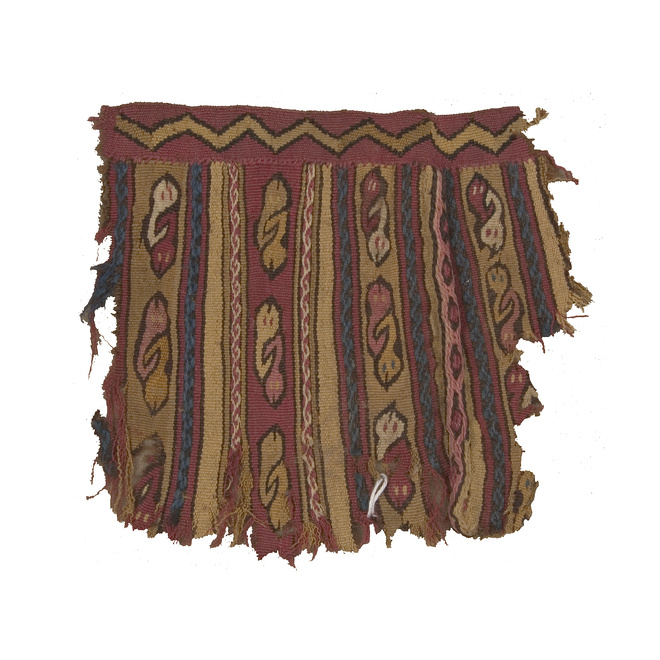
From the exhibition:
Carrying Coca: 1,500 Years of Andean Chuspas
This small textile fragment from Peru’s Nasca Valley was made about two thousand years ago. Three agents have contributed to its survival: its Nasca creator or creators; the valley’s arid climate, which preserved the piece; and Ronald L. Olson, the archaeologist from the American Museum of Natural History (AMNH) who acquired the piece for the museum’s collection.
The fragment appears to be one almost complete side of a chuspa, a type of small bag used throughout the Andean region for carrying coca leaves, although it is missing the remainder of the bag’s body and a chuspa’s characteristic carrying strap. For centuries, the region’s inhabitants have used coca leaves in religious and social rituals and have chewed them for a mild stimulating effect, helpful for coping with the challenges of living at high altitudes. This bag fragment was woven using the slit tapestry technique, in which discontinuous weft threads (forming the decorative elements) pass back on themselves to create areas of different colors and visible “slits” in the transition from one color to another. The threads are made of camelid fibers, possibly from alpacas that were laboriously spun and dyed with natural pigments to create vibrant shades of red, blue, brown, and yellow. Beautifully crafted, this textile attests to the importance of coca to the bag’s original owner, or owners, and to the time and effort invested to create a bag to carry the leaves.
Of particular interest is the chuspa’s striking motif of interlocking snakes. There is some evidence that snakes were not an uncommon visual element in Nasca textiles; for example, serpents adorn some skirts and dresses in a cache of textiles that was found at the Nasca site of Cahuachi.1 As with other kinds of Nasca material production, imagery from the Paracas culture, which preceded the Nasca, may have influenced the design of this textile. Serpentine figures have been found on excavated Paracas textiles that immediately predate this chuspa, including some from the Wari Kayan Necropolis (approximately 100 BC to AD 200).2 Yet the significance of these animal figures is hard to pinpoint with certainty. They may represent deities, or simply depict features from the surrounding landscape. The snakes may also be fanciful representations of textile structures; their interlocking bodies mimicking the weaving of threads. Cloth was extremely important to the Nasca people, and extant Nasca textiles attest to the high levels of technical complexity that weavers were able to achieve. It is possible that the creator or creators of this chuspa included the snakes as symbols of weaving to reinforce just how fundamental textile production was to Nasca culture.3
Acquired from the Nasca Valley on Peru’s southern coast, this fragment survived for almost two millennia because of the region’s extremely arid climate, one of the driest on earth. This aridity preserves organic material, including cloth, extremely well.4 Yet, it was due to the collecting practices of Ronald L. Olson that this piece, along with other Nasca textiles, was preserved in the AMNH’s collection. Originally from Minnesota, Olson earned his Ph.D. in 1929 at the University of California, Berkeley, where he studied with the pioneering anthropologist Alfred Kroeber. For the next two years, Olson was employed by the AMNH as an assistant curator of South American archaeology. His primary task was to lead excavations that would expand the museum’s holdings of South American archaeological material. The AMNH had not sponsored any archaeological or ethnographic research in that region since 1903. As a result, much of the material evidence that the museum had acquired from South America was acknowledged to be “without adequate data.”5
Olson led the AMNH’s Granger expedition (named for patron Myron I. Granger) from January to August of 1930. The expedition covered areas of Peru, Ecuador, and Bolivia, excavating in, “…the coastal valleys of Nazca, Iea, Chincha, Canete, Ancon, Huarmey, Viru, and Chancay, and in the valley of the Utcubamba (an eastern affluent of the Rio Marafon).”6 In addition to Granger’s support, Chicago’s Museum of Science and Industry contributed $500.00 to the expedition for Olson to assemble weaving tools for its collection. Perhaps prompted by this, Olson spent a great deal of time documenting local textile production, photographing weavers, and filming them for a short documentary entitled,Weavers of the Andean Highlands.
Unfortunately, Olson did not record the exact location where he found this bag fragment. The AMNH’s catalogue records only that the fragment came from the “Valley of Nasca,” so it is unclear if the piece was excavated there by Olson or if he acquired it in the region by some other means. Stylistically, the bag is similar to other examples of excavated Nasca textiles, so the label “Nasca” can be applied to the fragment with a high degree of confidence. However, without either knowing its exact find spot or further technical analysis, it is difficult to date the textile with absolute certainty.
Although a number of details about this textile remain mysterious, including the meaning of its iconography and the way in which Olson acquired it, a few things are evident. This fragment reveals that technically and stylistically sophisticated textiles were being woven in the Nasca Valley even two thousand years ago. Since this textile was part of a chuspa, it also reflects the importance of coca leaves as a part of the local culture even at that early date, attesting to the traditional intertwining of textiles and coca that has occurred in the Andean region for centuries.
1.Mary Frame, “The Nasca on the South Coast of Peru,” The Berg Fashion Library 2, no. 5 (last modified 2010). doi: http://dx.doi.org/10.2752/BEWDF/EDch2052www.bergfashionlibrary.com.library.metmuseum.org/view/bewdf/BEWDF-v2/EDch2052.xml ↖
2.Anne Paul, “Protective Perimeters: The Symbolism of Borders on Paracas Textiles,” RES: Anthropology and Aesthetics 38 (2000): 147–48. ↖
3.Ibid., 153. ↖
4.Lauren Finley Hughes, “Weaving Imperial Ideas: Iconography and Ideology of the Inca Coca Bag,” Textile 8 (2010): 160. ↖
5.Katherine A. Berger, ed., “American Museum Expeditions,” Natural History 30, no. 5 (September–October 1930): 553. ↖
6.Ibid. ↖
